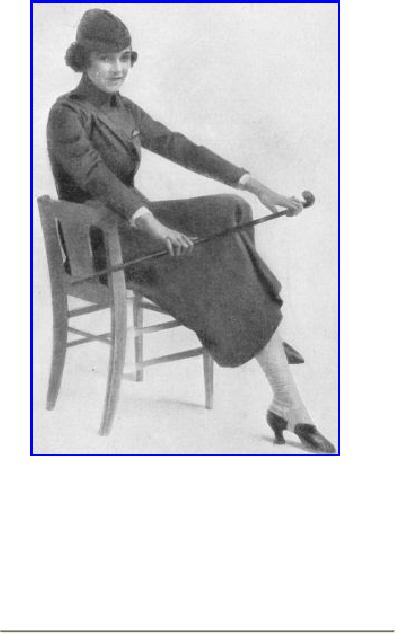 |
SEX IN COSTUMING |
| << WOMAN IN THE VICTORIAN PERIOD |
| LINE AND COLOUR OF COSTUMES IN HUNGARY >> |

CHAPTER
XX
SEX IN
COSTUMING
UROPEAN
dress" is
the term accepted to imply
the costume of man
and
woman which is entirely
cosmopolitan, decrying continuity
of
types
(of costume) and thoroughly
plastic in the hands of
fashion.
To-day,
we say parrot-like, that certain
materials, lines and colours
are masculine
or
feminine. They are so merely
by association. The modern costuming of
man the
world
over, if he appear in European
dress (we except court
regalia), is confined to
cloth,
linen or cotton, in black,
white and inconspicuous colours; a
prescribed and
simple
type of neckwear, footwear,
hat, stick, and hair
cut.
The
progenitor of the garments of
modern men was the
Lutheran-Puritan-
Revolutionary
garb, the hall-mark of
democracy.
It
is true that when silk was
first introduced into
Europe, from the Orient,
the
Greeks
and early Romans considered it too
effeminate for man's use,
but this had to
do
with the doctrine of austere
denial for the good of the
state. To wear the
costume
of
indolence implied inactivity and
induced it. As a matter of
fact, some of the
master
spirits of Greece did wear
silks.
In
Ancient Egypt, Assyria,
Media, Persia and the Far
East, men and women
wore
the
same materials, as in China
and Japan to-day. Egyptian
men and their
contemporaries
throughout Byzantium, wore
gowns, in outline identical
with those
of
the women. Among the
Turks, trousers were always
considered as appropriate
for
women as for men, and both
men and women wore
over the trousers, a
long
garment
not unlike those of the
women in the Gothic
period.
Thaïs
wore a gilded wig, but so
did the men she
knew, and they added
gilded false
beards.
Assyrian
kings wore earrings, bracelets and
wonderful clasps with
chains, by which
the
folds of their draped
garment,--cut like the
woman's, might be caught up
and
held
securely, leaving feet, arms
and hands free for
action.
When
the genius of the Byzantine,
Greek and Venetian manufacturers of
silks and
velvets,
rich in texture and ablaze with
colour, were offered for
sale to the Romans,
whose
passion for display had
increased with their
fortunes, and consequent
lives
of
dissipation, we find there
was no distinction made
between the materials used
by
man
and woman.
It
is no exaggeration to say that the
Renaissance spells brocade. Great
designs and
small
ones sprawled over the
figures of man and woman
alike.
Lace
was as much his as hers to
use for wide, elaborate
collars and cuffs.
Embroidery
belonged to both, and the
men (like the women) of
Germany, France,
Italy
and England wore many plumes
on their big straw hats and
metal helmets.
The
intercommunication between the
Orient and all of the
countries of the
Western
Hemisphere,
and the abundance and variety of human
trappings bewildered and
vitiated
taste.

PLATE
XXVI
Mrs.
Vernon Castle costumed à la guerre
for
a
walk in the country.
The
cap is after one worn by her
aviator
husband.
This
is one of the costumes--there
are
many--being
worn by women engaged
in
war
work under the head of
messengers,
chauffeurs,
etc.
The
shoes are most decidedly
not for service,
but
they will be replaced when the
time is at
hand,
for others of stout leather
with heavy
soles
and flat heels.
Mrs.
Vernon Castle Costumed á
la
Guerre
for a Walk
Unfortunately
the change in line of costume
has not moved parallel to
the line in
furniture.
The revival of classic interior
decoration in Italy, Spain,
France,
Germany,
England, etc., did not at
once revive the classic lines in
woman's clothes.
Table of Contents:
- A FEW HINTS FOR THE NOVICE WHO WOULD PLAN HER COSTUMES
- THE LAWS UNDERLYING ALL COSTUMING OF WOMAN
- HOW TO DRESS YOUR TYPE
- THE PSYCHOLOGY OF CLOTHES
- ESTABLISH HABITS OF CARRIAGE WHICH CREATE GOOD LINE
- COLOUR IN WOMAN'S COSTUME
- FOOTWEAR
- JEWELRY AS DECORATION
- WOMAN DECORATIVE IN HER BOUDOIR
- WOMAN DECORATIVE IN HER SUN-ROOM
- I. WOMAN DECORATIVE IN HER GARDEN:WOMAN DECORATIVE ON THE LAWN
- WOMAN AS DECORATION WHEN SKATING
- WOMAN DECORATIVE IN HER MOTOR CAR
- HOW TO GO ABOUT PLANNING A PERIOD COSTUME
- I. THE STORY OF PERIOD COSTUMES:II. EGYPT AND ASSYRIA
- DEVELOPMENT OF GOTHIC COSTUME
- THE RENAISSANCE
- EIGHTEENTH CENTURY
- WOMAN IN THE VICTORIAN PERIOD
- SEX IN COSTUMING
- LINE AND COLOUR OF COSTUMES IN HUNGARY
- STUDYING LINE AND COLOUR IN RUSSIA
- MARK TWAIN'S LOVE OF COLOUR IN ALL COSTUMING
- THE ARTIST AND HIS COSTUME
- IDIOSYNCRASIES IN COSTUME
- NATIONALITY IN COSTUME
- MODELS
- WOMAN COSTUMED FOR HER WAR JOB
- IN CONCLUSION